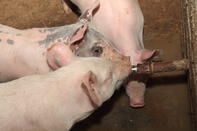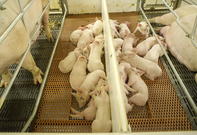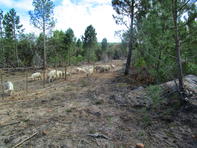
Requirements of Pregnant Sows
The sow, is the least demanding when pregnant (called a ‘dry sow’ in the industry) but she still has needs. A pregnant sow needs the company of other sows and needs protection against hot sun, cold winds and rain. She needs enough space to move freely and behave like a pig. Most small herds do not use farrowing crates for their sows.
Some farmers only confine the sows for the first few weeks after mating to treat problems and observe the sow after her three-week period to make sure she has been successfully served and is pregnant.
The pregnant sow needs sufficient feed but not too much. About 2 to 3 kg per day with all necessary ingredients including a high fibre content such as bran, hay, green feed (if available) and with at least 12% protein.
All millers will be able to supply a “sow and boar” meal or pellets and this should make up at least half the sows’ diet with the balance coming from the by-products that are available form dated or stale or sour ingredients.
Note: never feed mouldy or stinking food to pigs and definitely no animal meat. Meat is a very efficient spreader of infectious diseases.
For the last week before her expected farrowing date (keep records) move the sow to her single farrowing pen. This hut, crate or shelter must be weather-proof, pig-proof, very clean and with plenty of bedding to allow her to make a nest.
Requirements of the Newborn Pig Litter

It is very important to realise that the temperature and environment requirements of the sow and her litter are different. The sow likes it cool, but the piglets need all the warmth they can get. It is desirable to provide them with a ‘creep’ i.e. a closed shelter like dog kennel with a removable lid to allow easy cleaning and observation.and replacing damp or smelly bedding.
The best bedding is pine shavings. Protect the entrance so that piglets can enter but not the sow; especially when feeding the piglets with their very expensive ration. The sow, unless she is in a farrowing crate, will be inclined to lie on top of slow sucklers and there will be losses due to crushing. The sow needs unrestricted clean water always available.
The sucklers will start drinking water to supplement the sow’s milk when a few weeks old. After giving birth, the sow needs a much richer diet when producing milk. It is ideal to feed the lactating sow ‘lactating sow feed’ and plenty of it – 6kg per day is not unusual. The lactating sow must never be hungry.
Feed her three times per day to prevent overloading her stomach. Piglets will start eating their mom’s food out of curiosity from a week old or so but the sow food is indigestible for the newborns.
Rather give the babies a weaner ration from about ten days before they are weaned and restrict the daily amount to 250 g (size of a coffee mug) for the next five days, Increase the amount daily so that their digestive systems are ready to cope with dry food at weaning.
Requirements of the Boar

The boar is sometimes called the most neglected animal on the farm despite supplying half the genes and therefore the quality of the next generation. The needs of a boar are fairly simple: He needs his own boar pen to be used for serving sows. Always bring the sow to the boar and keep records of his services.
Between services he can stay with the dry sows – his presence is beneficial and has a settling effect. He will also detect sows that are on heat if they have aborted and he may well have served them. Keep records. Often the boar is allowed to be part of the herd in a free-range situation. The serving of sows on heat will be on a “let nature take its course” basis.
This has some disadvantages. The pig farmer may not know which sows are pregnant and from which day and by which boar (if there is more than one). Also, the expected date of birth will not be known, making it difficult for planning. If there is more than one boar in a herd, they may battle for seniority.
The dominant or only boar will have no restriction on how many times he serves each sow. This can result in tired, sub-fertile boars and injured sows or especially, gilts. The boar needs regular and thorough treatment for mange as he is usually the spreader of mange to the whole sow herd.
This is transmitted during the mating time of 6 to 15 minutes. (Treatment for mange is not difficult and is effective if instructions are followed.) Limit the feeding of a boar to prevent him from becoming overweight, lazy, infertile and a bully. His ration and amount will be the same as for the dry sows.
By Dr Jim Robinson